Sampson State Park Ganondagan – Pride of the Seneca Nation
Romulus, New York Over the Frost Heaves and Down the Rabbit Hole
Today we set out again and early for Ithaca New York. It’s a 38 mile trip to Sapsucker Woods, the Cornell Ornithology Lab. On our way, we pass a sign that says Viewpoint for Taughannock Falls. This state park had been on our list of must sees in this area and then we were told that it was nothing but a trickle due to the drought. But since we are driving right by, and they promise an “overlook” without a hike, we decide to take a look.

I’d call this more than a “trickle” but clearly a mere shadow of all the pictures we have seen of it including those in the blogs of friends who highly recommended it as a great hiking area and a fantastic falls.

My camera zoom gives me a very good look at the amount of water at the top and coming over the brink.


One of the things lots of people love about Taughannock is that you are allowed to swim in the pool below the falls. But not today. It is closed. Too shallow, too dangerous.

Just another on my list of things to return to on a year where I have checked the drought situation before I come. That of course means no reservations which isn’t possible in the summer since without reservations you can’t stay in the Finger Lakes State parks for more than a night or two at the most mid week.

We arrive at the lab before the visitor center is open for the day.

But the trails are open dawn to dusk and like other helpful hiking locations they have maps outside for us to take with us on the trails. There is also a bird check list for the sanctuary. The maps aren’t quite as detailed or as well color coded as the large one posted on the wall so I take a picture of it to take with us as well.


Just off the building patio is a very moving tribute to the Passenger Pigeon. I have heard for years about the flocks of these pigeons which were so numerous they would darken the skies.and that they were hunted to extinction. It was their sad fate that luckily motivated the protections for the plume birds who were also being slaughtered in great numbers in the late 19th Century for their feathers as decorations for women’s hats.
This is a very beautiful sculpture and plaque. I’m sorry I didn’t stand next to it so that you could see how large it is. I come up to his neck. Very fitting for this country’s foremost birding authority.



We head down the trail in search of another treasure we know is here. Sapsucker Woods is a 230-acre sanctuary described as encompassing forests, ponds, and ferny swamps. More than four miles of trails and boardwalks are here for us to explore.


All the paths here are lined with inches of chipped bark and are so cushioned I think I could walk them barefoot.

It’s July in New York state, spring migration is over, fall has not yet begun so we aren’t expecting to see many if any birds. But we do see this thistle just starting its blooming. I think it is lovely.

This bridge takes us through what is usually a wetland I would suppose but it is bone dry today.

I don’t tell David but I know at least which trail our treasure is on and head in that direction.

How could I have thought that the Ornithology Lab would allow us to go birdless.

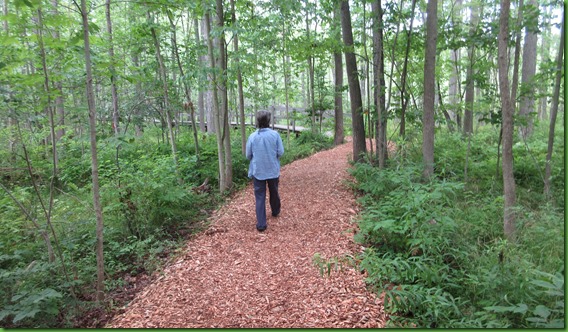
These little guys are right in the trail and so small that I can’t imagine they won’t be smashed by folks not paying attention at their feet. They are nearly transparent.

They are very very tiny.

The woods is wonderfully cool and this early, we have it all to ourselves. Few things are better than this.

Except our treasure when I see it through the trees.
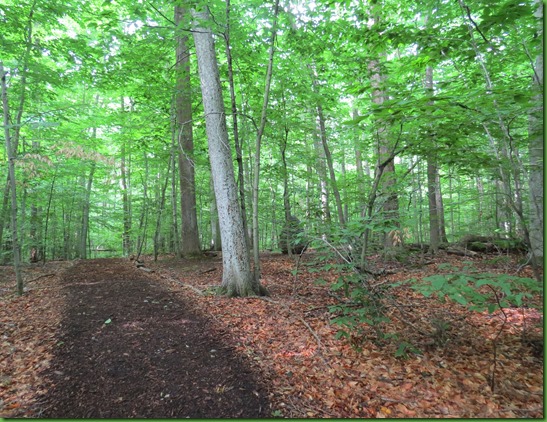
It is a natural sculpture created by the internationally famous environmental artist Andy Goldsworthy. The cairn was built in April 2008 over 4 days by Goldsworthy and students from Cornell using 10 tons of locally quarried stone.

Sapsucker Cairn has a presence in the woods. It gives off a feeling of peacefulness and calm.

To give you an idea of its size. This is me with Sapsucker Cairn. I’m 5 feet tall.

And this is David with Sapsucker Cairn. He’s 5’ 10.

In May of 2008, The Cornell Ornithology Lab put out this information and short video of 3 1/2 minutes about the Cairn which was created the previous month over a period of 4 days.

I find it hard to leave the cairn and I look back through the trees several times as we walk on down the trail.

If you are interested in the art of Andy Goldsworthy and other amazing works by him, there is a wonderful documentary entitled Rivers and Tides which we own and found incredible. This link has the best pictures and explanation of some of his other remarkable works. This one has pictures but no description however it has at least part of the video Rivers and Tides. Artsy has 20 of his works, articles, and exhibition listings

We enjoy the rest of our hike in the lovely Sapsucker Woods.

It appears to have been a bit of a rough life for this butterfly.

Life is just coming into flower for these thistle.
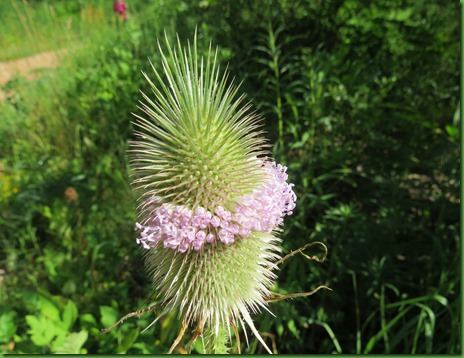

As we return to the now open Visitor Center, we spot just this much of a garter snake under the boardwalk side slats. Wish I could have seen all of him.
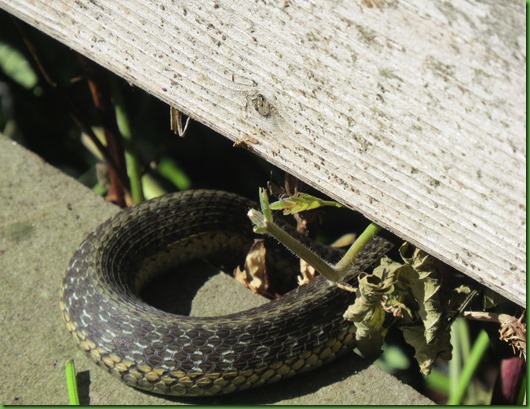
For this summer when it is unusually hot here in the Finger Lakes, this wall of windows with chairs for viewing is another way to experience the birds.

I must admit to being completely taken back by all the unexpected art at this “laboratory”. Labs always make me think of biology disections and chemical experiments. But this is a very different kind of lab which I’ll get to in a minute.
On the walls of the hallway in the Visitor Center are two of the most marvelous murals I’ve ever seen. On the left surrounding the Wild Birds Unlimited store is The Wall of Silhouettes by James Prosek. Anyone who has ever used a Peterson’s Field Guide for Birds will recognize the front papers of the book in these silhouettes which cover the wall from floor to ceiling. These 140 silhouettes are both familiar and strange. I find myself standing and looking in every direction surprised by how many silhouettes I recognized. A key is available at the main desk if you really want to know if you are “right”.

I’d sure like to have Judy Bell and Mona Liza Lowe here with me to see this.

How many do you recognize? They are all life size.



Before showing the mural on the other side of the hall, I want to show the rotating exhibit in the multipurpose room. We might not have known these were here had we not asked to see the film on the Ornithology Lab which they usually show on the hour. Apparently there were so few people that when we went into the room, we waited and waited and then went out to ask. Someone seemed to have dropped the ball but they got right on it. In the mean time, we walked around the room looking at the incredible photographs of extraordinary nests. These are real nests that were photographed mostly from collections in museums. They are nests created by birds, not nests created by artists.
Beautiful art created by our feathered friends.
The Caspian Tern, Baja California, Mexico 1932
The Caspian Tern, Baja California, Mexico 1932

Hoary Redpoll Alaska 1896
Black Capped Vireo in Texas 1888
Tree Swallow nest Washington 1995
Swainson’s Thrush California 1925

We were only able to look into the windows of most of the labs like this one.

But we were able to go into the student lab where there are specimens, some of them extinct animals.


Remember this bird. He’s extinct but you will see him later.

On of the most amazing things we see is out in the hallway among all the Academic Abstract Posters presented at proessional meetings. It is the skeleton of a 26’ long python. How Cornell got it is an interesting story.
In 1915, during a hunting expedition in the mountains of the Philippine island of Luzon, a U.S. Army administrator and a group of officers and locals were sitting around a campfire when they were startled by a commotion in a nearby tree. the officer fired his shotgun into the darkness in the direction of the sound. Moments later something large crashed to the ground. By the morning light, the group discovered a dead 26-foot-long reticulated python beneath the tree. It was too big to carry, so they laid the carcass over some anthills and returned a few days later to find nothing left but bones. The skeleton was given to Cornell by a graduate who kept the relic from his father’s army days. The skeleton was assembled from bones that had been stored with the vertebral column strung on a cord and the ribs and skull elements in separate boxes. A group of professors reassembled the skeleton from almost 1,000 vertebrae, ribs and head bones. Talk about an amazing puzzle to put back together. I’m just in awe. How did they possibly do it? They think the snake may well be the longest snake on display in the world. The giant female python weighed close to 165 pounds,

Not sure what caused my close up of the snake to be the correct color and my distant picture to be more tan. Neither was taken with a flash. But that’s sure some snake. Wonder what would have happened had he not shot up into the tree over their heads which seems like a rather dangerous thing to do.

After the tour, we go back outside and have lunch on the bench next to the passenger pigeon statue. No picture, too hungry I guess.
Most of the things on the wall in the central hallway of the lab are professional posters but there are some information posters on the lab’s research. One of them is about the Bioacoustics Research Program which develops and uses digital technology, including equipment and software, to record and analyze the sounds of wildlife around the globe. By listening to wildlife, they advance the understanding of animal communication and monitor the health of wildlife populations. They help policy makers, industries, and governments use this information to minimize the impact of human activities on wildlife and natural environments. These scientists lead acoustic studies of whales, elephants, and birds to advance the understanding and protection of wildlife.
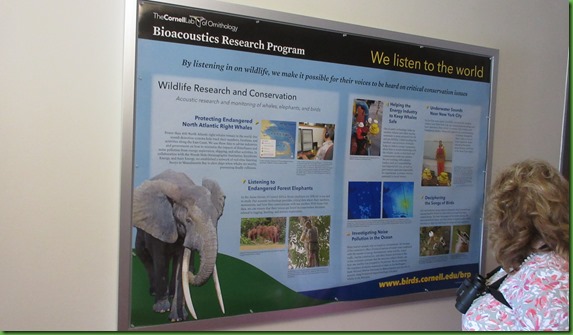
One result of this research that is wonderful is the The Natural Sounds Kiosk that we use to hear the sounds made by various types of birds in places all around the world. I wish you could see the screen better so you could see the beautiful birds to choose from and even better would be if you could hear them. My attempt at a video didn’t pick up the sounds well enough. We were there a long time. Each of us trying several birds and being amazed at how different some of them sound from anything we’d ever heard of before.

And then there was the video room. Here you could choose on a touch screen menu from many videos made of research in the field by Cornell professors. They ranged from about 3 min long to 25 minutes long. There were also Birding How To videos. We probably could have spent an entire day in there.

I’m only going to show examples of two of the videos we saw but everything we saw was wonderful This is a picture of the screen during the Bird of Paradise Video showing the collaboration between Cornell and National Geographic to spend a decade videoing all 39 Bird of Paradise Species in their display dances. You’ll have a hard time believing this even when you watch this 5 minute video summary of what we saw.

The other one I’ll mention is about the artist, Jane Kim, who created the Great Wall of Birds. There is a video of her creating the wall and talking about it. These next two photogrpahs are pictures from the video we saw.


This mural, 3000 square feet in size covers one whole wall of the lab’s visitor center. The mural is titled “From So Simple a Beginning: Celebrating the Evolution and Diversity of Birds” taken from Charles Darwin’s Origin of the Species. It documents the 375 million year history of birds . It represents species from each of the 243 modern bird families, five extinct modern bird families and 21 extinct evolutionary species, They are life-sized birds drawn to scale and laid over a world map. The placement of each bird is largely based on where it was most often recorded on eBird, a real-time online citizen science Web platform for recording bird sightings that is administered by the Cornell Lab of Ornithology and the National Audubon Society. This program is part of Cornell’s citizen scientist program to involve us all in their work. eBird can be downloaded for the iphone or the droid.

In the mural, extant birds are painted in color, while extinct species are shown in gray scale. Jane Kim used subtle storytelling cues in the mural, such as having all the New World birds looking toward Old World, while the birds in Africa face the New World. East of Africa, the Old World natives face the Americas, but from the other direction.
Kim said, “The birds beginning in the Old World are looking back on the New World and at a certain point it shifts because it’s circular. It’s a narrative I had in the back of my mind as I was placing the birds.”
And then there’s a black caiman, most closely related to alligators, in the bottom of the mural.
“The order Crocodillia and birds are each other’s closest living relative,” Kim said. “That is a cool bit of information, that alligators have more in common with birds than with lizards.”
The mural took 16 months of continuous painting. She did a bird a day at a minimum from a rolling scafolding that could be raised and lowered as needed.

This is about the best I could do at getting the largest portion of this giant mural even with my wide angle lens. This is taken from the second floor overlook.

This is looking down from the top of the stairs at a parade of extinct birds leading to North and South America.

Looking up from down stairs at Africa.
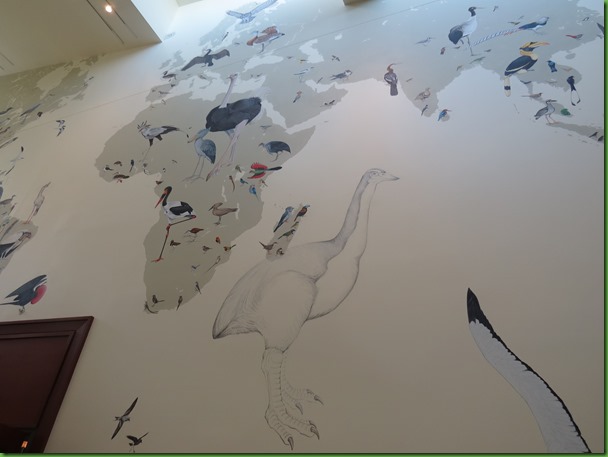
I then took the individual continents. The bird’s feet all are placed in their specific home area of their continent. The detail here is amazing. Remember these are representatives of 243 families of birds.





If you’d like to see a short piece of the video we saw with Jane Kim talking about the creation of this mural, you can find it at this link. The video gives a better sense of the size and detail of this mural than my pictures can ever do. This is an outstanding work of art that I would encourage you to experience for yourself. The video may be a distant second in terms of experience.




While we are up on the second floor we played with the Wall of Birds interactive exploration. Here we could point to any bird on the wall and click it for the name of the bird and information about it. Cornell has generously put this program on line and you can use it here at this link. Once you are in the program you can use the + and – to zoom in or out to pick your birds. One click and there’s the information. Zoom again to another bird and spend as much time as you dare being amazed at this incredible accomplishment by the Cornell Lab and Jane Kim.
We have had an unbelievable day at the Cornell Lab of Ornithology in Ithaca New York. It deserves a visit from everyone and is for sure a place I want to return to.

We can’t finish a great day any better than to have our friends Dave and Sharon over for dinner. As you can see, the food was nearly over by the time I thought to take this picture and the sun was whitening my background as it fell lower and lower in the west.

We worked off our dinner with a few games of ladder ball. Sharon said she’d never played before so she paired with David and poor Dave was stuck with me.

Lucky for me he’s a good player and kept our score competitive. But David and Sharon still beat us two out of three.

They leave us tomorrow to head for 4 Mile Creek and a visit to Niagara Falls. We’ve just luckily crossed paths here and we’re sure glad we did. We’re really going to miss them. Safe Travels!!





I love places like the lab. The picture of the garter snake surprised me. I thought they were very plain. Learned a lot from you today as I always do. :-)
ReplyDeleteThat looks like a great way to spend the day. The Birds of Paradise video is truly amazing!
ReplyDeleteEnjoyed the post, lots of pics to show what is there.
ReplyDeleteThis is a bird lover's paradise! I'm surprised you were able to see it all in one day. What a great facility! I lived in Ithaca when I was a toddler. My father went to Ithaca College after the Navy. We camped there with our kids during our couple years living just across the border in PA.
ReplyDeleteNOw you're in my old stomping grounds. I took a number of classes at the Lab back in the 70's and 80's. There was no huge visitor's center back then, but Sapsucker Woods was there.
ReplyDeleteThe lab looks quite well worth a visit to- the python is particularly impressive.
ReplyDeleteGiven the general weather conditions this summer in this part of the continent- Ithaca is not that far away from here- it's not a surprise that those falls would be like that. I can imagine what they're like at full force.
I need to spend a few weeks there so I might finally know enough birding to identify more than a Raven and a Dove :-) What an amazing place. Love the Passenger Pigeon tribute. The Sapsucker Cairn is very special, I can feel the draw in your photos. The first place we saw indoor bird-watching chairs was at the refuge in Roswell, and I thought it was a great idea! The lab's theater actually looks comfortable enough to spend time seeing a few videos - very nice :-) The mural is amazing to see, and thank you for including the info on the process - wonderful!
ReplyDeleteWow, that is a lot to amaze in one day! I had heard about the Cornell Lab of Ornithology, but this place really is way over the top of my expectations in every way. There is so much to learn here and inspire. Thank you for pointing out some of the incredible things we saw there!
ReplyDeleteOver 40 years ago my kids listened to "A Night In Sapsucker Woods"... I believe it was on a vinyl record. I didn't know, until your blog, that Cornell actually HAS the place open to visitors. Your tour was wonderful... I'm putting that place on my wish list for sure!
ReplyDeleteWow, what an amazing place! Would be very cool to take classes there.
ReplyDeleteAmazing mural, you get quite an education just looking at it. Very well done. I didn't know birds and gators were so closely related. I'm glad that birds don't have the teeth that gators do!
ReplyDeleteI liked that cairn in the woods, must have been quite an effort to lug and fit all those stones to get the shape.
What a wonderful day at Cornell Lab...You know it is now on my TODOS list. Like I said before you take us to the most interesting places:o))
ReplyDeleteAlso, you meet the most interesting people...some of our favorites!!!
What a wonderful experience! I know I would lovethe lab.
ReplyDeleteI have seen the Goldworthy documentary, it is excellent!
I love this post! The Cornell Ornithology Lab is enough of a reason for us to get ourselves to New York. We've recorded our bird sightings on e-Bird for several years now. It's a really fun way to participate in "citizen science" as we travel. Those murals are fabulous—and the bird nests are truly works of art. It looks like we could happily spend at least a couple of days at the lab. Even an Andy Goldsworthy sculpture! I love his work! His ephemeral sculptures in nature were my inspiration for our Art on the Beach sea star sculpture on Lopez last year. Thanks for sharing so much beauty in this post.
ReplyDeleteOMW!!! Such an amazing place to visit. That carn is the best ever. I love my Peterson guide and that mural of silhouettes brings back memories of using it. The other mural is over the top. Those nests are truly a work of nature's art. What a job it must have been to put together that python skeleton. Looks like a place to spend many days exploring.
ReplyDeleteWhat an awesome place to explore. Now this place would go a long way to improve my bird knowledge which is extremely lacking. I will have to reread your post just to absorb all the info you provided with the pics. Definitely a place I would like to visit.
ReplyDeleteCan't wait to visit that lab! I have an aunt who lives near there, but I'll guarantee you she's never been to any of the places you are visiting. Maybe someday we'll go and take her to them.
ReplyDeleteAmazing! Too bad the falls were in a drought, but still quite magestic. I love the picture showing a reflection off the lake. Beautiful mural at the lab. And, I love the nest pictures - what artisitic bird friends. Very sad about the passenger pigeon - I am glad they are memorialized at least. Everything in this blog is impressive - that cairn must be so neat to see in person given its size.
ReplyDelete